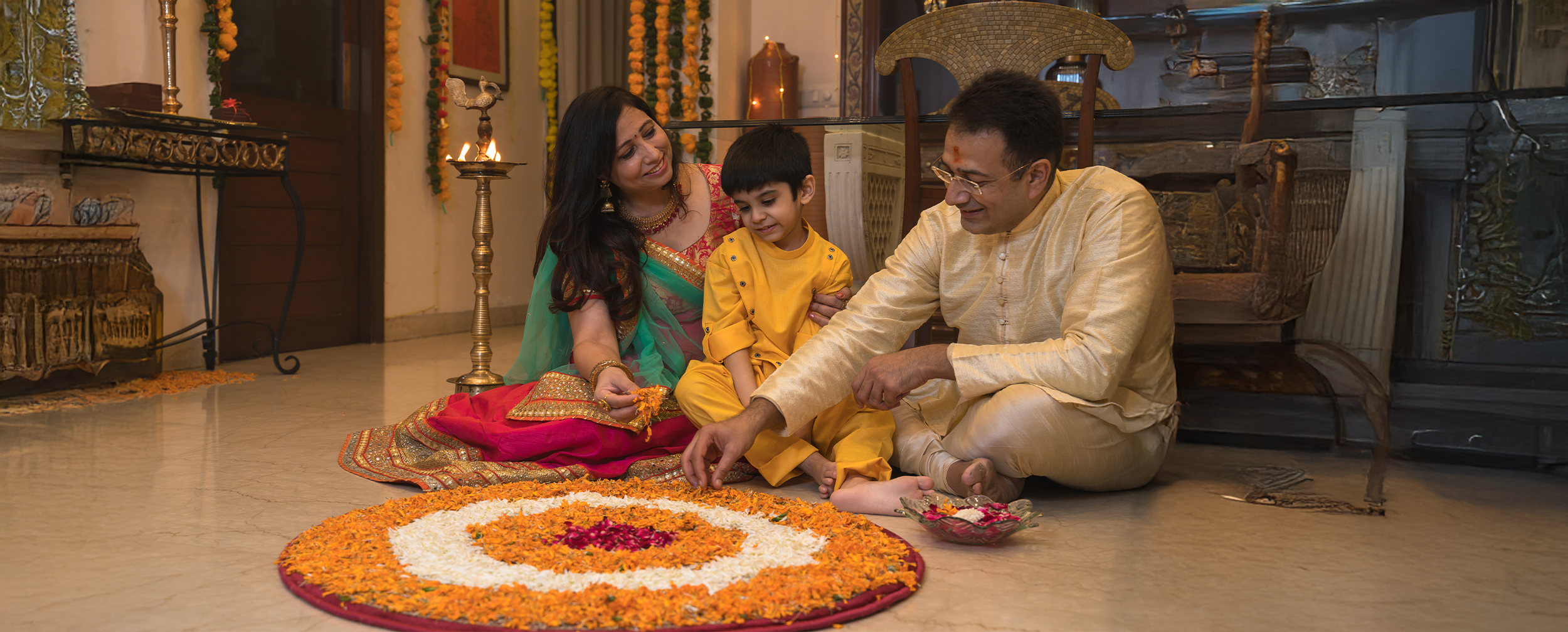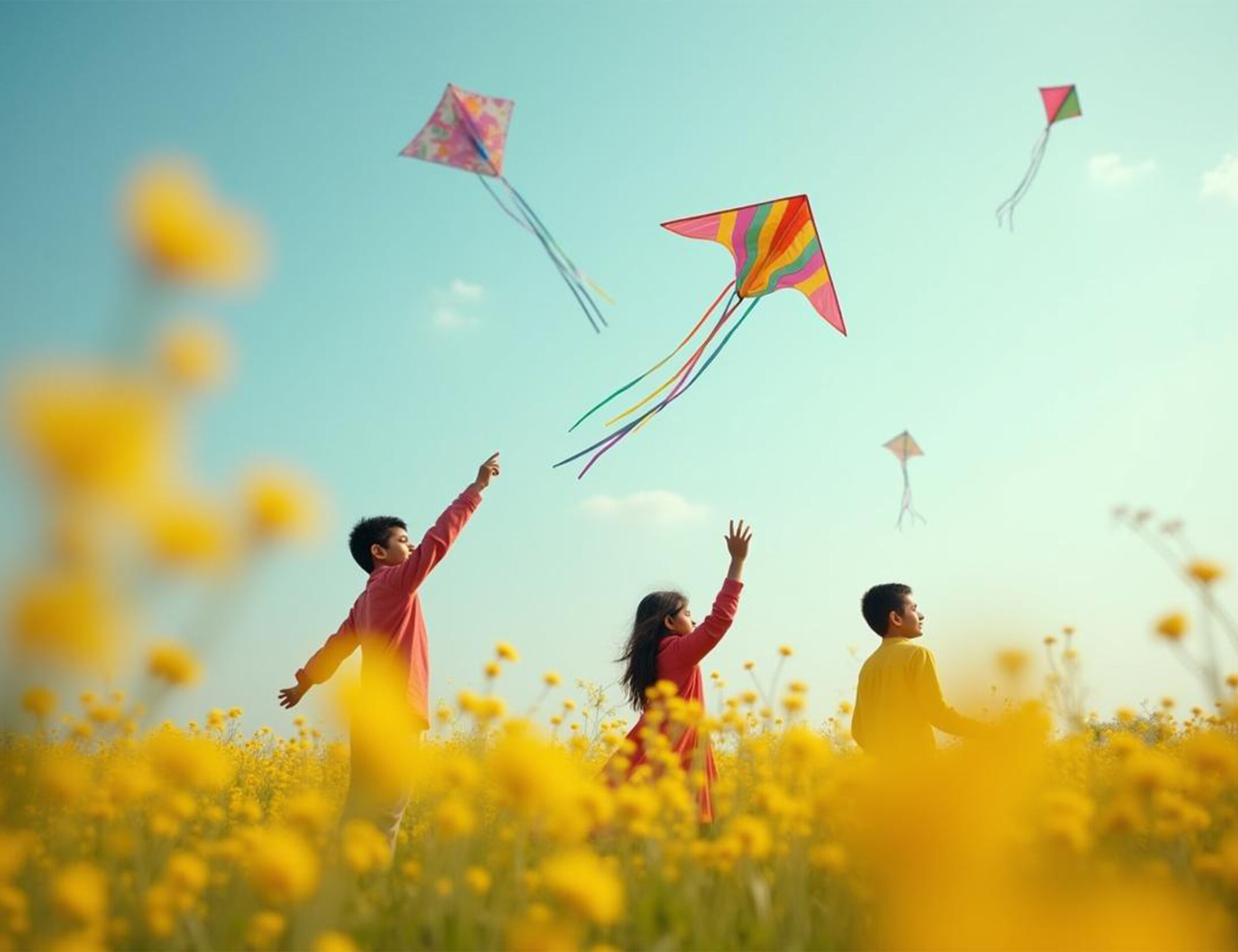STORIES BY DIWAS

Lifestyle
Basant Panchami Decoration Ideas: Kites and Rangolis Steal the Show
Date 1 February 2025 Reading time: 7-10 mins
Spring is in the air, and with it comes the joyous celebration of Basant Panchami. As you gear up to welcome the season of new beginnings, there are two decor elements that you simply can't miss - kites and rangolis. These vibrant symbols of Basant Panchami not only add a splash of colour to your festivities but also carry deep cultural significance.
In this blog, we'll explore why kites and rangolis are the ultimate Basant Panchami decoration must-haves. From their rich history to creative ways to incorporate them into your celebration, get ready to make your decor soar to new heights!
Introduction to Basant Panchami
Basant Panchami, also known as Vasant Panchami, is a festival that marks the arrival of spring. Celebrated on the fifth day of the Hindu month of Magha (usually late January or early February), it's a time to bid adieu to the winter chill and embrace the warmth and vibrancy of a new season.
Significance of Basant Panchami
For many, Basant Panchami holds deep spiritual significance. It's believed to be the birthday of Goddess Saraswati, the deity of knowledge, music, and art. Devotees across India offer prayers to the goddess, seeking her blessings for a year filled with wisdom and creativity.
But Basant Panchami is more than just a religious occasion. It's a cultural celebration that's steeped in traditions unique to different regions of India. From wearing yellow clothes to eating sweet delicacies like kesar halwa and boondi ke ladoo, every custom is a reflection of the joy and optimism that the festival brings.
Why Decorations are Essential for Basant Panchami
Just like any other Indian festival, decorations play a crucial role in setting the mood for Basant Panchami. They not only add visual appeal to your home but also create an atmosphere of festivity and togetherness.
When it comes to Basant Panchami decoration, two elements stand out - kites and rangolis. Let's dive deeper into why these are considered essential:
Role of Kites in Basant Panchami Decoration
History and Significance of Kites in Basant Panchami
Kite flying is an integral part of Basant Panchami celebrations, especially in North India. The tradition is believed to have originated in 16th century Delhi during the reign of Mughal Emperor Akbar. It's said that the emperor would organise grand kite flying festivals to mark the arrival of spring.
Over time, the custom spread to other parts of the country, becoming a beloved Basant Panchami ritual. Today, the sky on Basant Panchami is a sight to behold, with colourful kites of all shapes and sizes dotting the horizon. People often engage in elaborate Basant Panchami kite decoration to make their kites stand out in the sky.
But kites are more than just a pretty addition to the festivities. They symbolise freedom, joy, and the human spirit's ability to soar high. As you watch your kite dance in the wind, it's a reminder to let go of your worries. Whether you’re participating in the annual festival or admiring from the ground, the Basant Panchami kite decoration brings a sense of excitement and joy to the occasion.
How to Make and Decorate Kites for Basant Panchami
While you can always buy readymade kites, making your own can be a fun family activity. All you need is some paper, bamboo sticks, string, and glue. Here's a quick guide:
- Cut the paper into a diamond shape.
- Place two bamboo sticks in a cross shape at the centre of the paper.
- Fold the paper over the sticks and glue it in place.
- Tie a string to the centre of the kite and you're ready to fly!
For Basant Panchami kite decoration, you can lend your kite a personal touch. Decorate it with your favourite colours and patterns and use paint, markers, or even stickers to create a unique design that represents the joy and vibrancy of the season.
Many people take great pride in kite decoration for Basant Panchami, spending hours perfecting their kite’s look. From intricate patterns to bold colours, the process of decorating is just as important as the kite flying itself.
Role of Rangolis in Basant Panchami Decoration
History and Significance of Rangolis in Basant Panchami
Rangolis, also known as kolams or alpanas, are intricate floor designs made using coloured powders, rice flour, or flower petals. They are an essential part of Indian festivities, believed to bring good luck and prosperity to the household. Rangolis play a significant part in the decoration for Basant Panchami to welcome the season of spring.
Decorations for Basant Panchami often include rangolis in shades of yellow and orange, symbolising the colours of spring. Many also incorporate motifs of Goddess Saraswati, such as a veena, a book, or a swan. These bright and vibrant shades are believed to invite positive energy and blessings into the home.
Creating a rangoli is seen as a meditative and spiritual act, welcoming the divine into your home, seeking blessings for the year ahead, and serving as a beautiful decoration for Basant Panchami that enhances the celebratory atmosphere.
For families, the rangoli is often the first thing they prepare in the morning as a part of their prayers. It becomes a symbol of both devotion and joy, making it a cherished decoration for Basant Panchami that sets the tone for the day's celebrations.
How to Make and Decorate Rangolis for Basant Panchami
Making a rangoli for vasant panchami decoration may seem daunting, but with a little practice, you can master the art. Here are some tips to get you started:
- Start with a simple design, such as a flower or a geometric pattern.
- Use a pencil to lightly sketch the outline on the floor.
- Fill in the design with your chosen colours, starting from the centre and working outwards.
- Add details and embellishments, such as dots, lines, or glitter, to make your rangoli pop.
If you're feeling adventurous, try incorporating some Basant Panchami-specific elements into your rangoli. You could create a kite-shaped design or use yellow and orange flower petals to symbolise the colours of spring. This will make it a beautiful vasant panchami decoration for your home.
For a more personalised touch, consider adding elements like Goddess Saraswati’s motifs or bright yellow flowers. These can turn your rangoli into a meaningful vasant panchami decoration, rich in tradition.
The Impact of Kites and Rangolis on Basant Panchami Decor
As we've seen, kites and rangolis are not just mere decorations but powerful symbols of the joy, hope, and spiritual significance that Basant Panchami brings. They have the ability to transform your home into a vibrant spot of positivity and festivity.
And don't forget, your outfit can truly enhance the spirit of the festival, perfect for celebrating Basant Panchami and complementing your vasant panchami decoration.
Explore the timeless kurtas for men from Diwas, perfect for all your Basant Panchami fashion needs. With a diverse selection of both traditional and contemporary styles, you're sure to find something that matches your unique sense of fashion. Whether you prefer a classic look or a modern twist, Diwas offers an incredible festive collection designed for the occasion. You’ll also find stylish kurta pajama for men, ideal for celebrating Basant Panchami in both comfort and style.
Here's wishing you a happy and colourful Basant Panchami!



